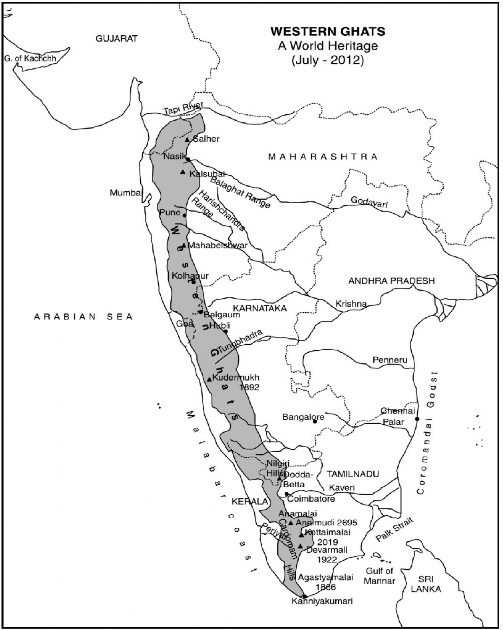WESTERN GHATS: A WORLD HERITAGE SITE
Western Ghats has been included in the UNESCO World Heritage List in the meeting of the World Heritage Committee held at St. Petersburg in Russia on 1st July, 2012.
The Western Ghats has "outstanding examples representing significant ongoing ecological and biological processes in the evolution and development of terrestrial, freshwater, coastal and marine ecosystems and communities of plants and animals. Il is also the most significant natural habitat for in-situ conservation of biological diversity, including those containing threatened species of outstanding universal value from the point of view of science and conservation. Apart from the World Heritage Site, it is one of the eight hottest hot spots of biological diversity in the world.
The Western Ghats or the Sahyadri is a mountain ranee sec 're western see of the Peninsular India. It separates the Deccan Plateau from the narrow coastal plain along the Arabian Sea (Fig.5.8).
The Western Ghats starts south of the Tapi river in Gujarat and runs about 1600 km through the states of Maharashtra, Goa, Karnataka, Tamil Nadu and Kerala ending at Kanniyakumari, at the southern tip of India.
The main peaks of the Western Ghats are: Anaimudi (2695m), Doddabetta (2636m), Mukurthi (2554m), Kodaikanal (2133m), Bababudangiri (1895m), Kudremukh (1894m), Agasthymalai (1866m), Pushpagiri (1712m), Kalsubai (1646m), and Salher (1.567m). The important hill stations of Ooty (2500m) and Kodaikanal (2285m) are also located in the Western Ghats.
The area has 5000 species of flowering plants, 139 mammal species, 508 bird species and 179 amphibian species. According to one estimate 325 globally threatened species occur in the Western Ghats.
The Western Ghats ate covered with the tropical and subtropical forests that provide food and natural habitats for the native tribal people. The area is ecologically sensitive to development. The Government of India has established many protected areas including 2 biosphere reserves, 13 national parks and several wildlife sanctuaries to protect specific endangered species. The Nilgiri Biosphere Reserve (5500 sq.km) of the evergreen forests of Nagarhole, the Bandipur National Park covered with deciduous forest, the Mudumalai National Park and the Mukurthi National Park in the states of Kerala and Tamil Nadu are the other important protected areas. A judicious use of resources and conservation practices can improve the resilience characteristics of the ecosystems of this important world heritage site.

